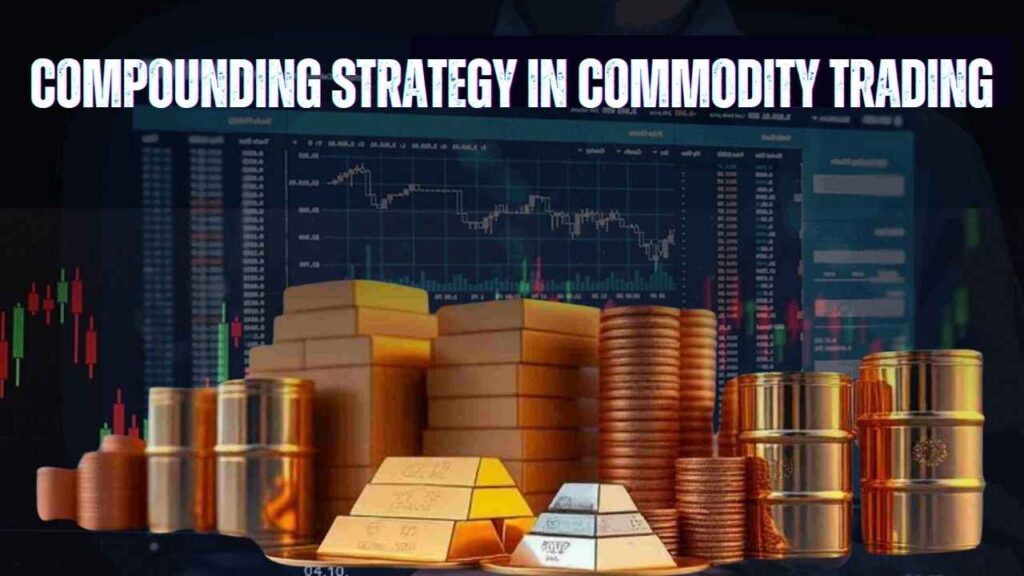In investment, compounding is the process of investing earnings to make more returns in the long term. In commodity trading, compounding can help small profits amount to substantial returns by reinvesting returns over and over again to enjoy the power of exponential growth. As opposed to standard stock investments, commodity trading is characterized by distinct challenges like price volatility, market fluctuations, and geopolitical influences. But with a well-planned compounding strategy, traders can use these fluctuations to generate spectacular long-term performance.
What is a Compounding Strategy in Commodity Trading?
A compounding strategy in commodity trading involves reinvesting your trading profits back into the market to create a snowball effect on your returns. Here’s how it works:
- Reinvestment of Profits: Instead of withdrawing your earnings, you continuously reinvest them into additional trades.
- Exponential Growth: Over time, the reinvested profits generate further earnings, resulting in exponential growth of your trading capital.
- Long-Term Focus: This strategy requires a long-term perspective, as the power of compounding becomes significant over extended periods.
For instance, if you consistently gain from trading commodities like gold, oil, or crops, using the gains to reinvest will allow you to realize even greater profit when the market is on your side, making your total returns greater.

How to Implement a Compounding Strategy in Commodity Trading
Here are some key steps and techniques to help you implement a compounding strategy effectively:
1. Start with a Solid Trading Plan
- Set Clear Goals: Establish long-term financial goals and determine the percentage of profits you plan to reinvest.
- Risk Management: Create rules for managing risk, such as stop-loss orders and position sizing, to protect your capital.
2. Reinvest Profits Consistently
- Automatic Reinvestment: Whenever possible, automate the reinvestment of profits to ensure you don’t miss out on compounding benefits.
- SIP-like Approach: Consider adopting a systematic investment approach similar to a Systematic Investment Plan (SIP) but applied to your trading profits.
3. Monitor and Adjust Your Strategy
- Regular Review: Keep track of your trading performance and the effects of compounding. Adjust your reinvestment rates and risk parameters as needed.
- Market Trends: Stay updated on market conditions and adjust your strategy to account for volatility and emerging opportunities.
4. Use Diversification to Mitigate Risks
- Spread Your Investments: Diversify across different commodities to reduce the impact of price volatility in any single asset.
- Asset Allocation: Balance your portfolio with investments in both high-risk, high-return commodities and more stable assets.
Advantages of a Compounding Strategy in Commodity Trading
Accelerated Growth
- Exponential Returns: The reinvestment of profits can lead to exponential growth of your trading capital over time.
- Earning on Earnings: As your profits compound, each subsequent gain builds on a larger base, accelerating the overall growth rate.
Enhanced Capital Efficiency
- Better Utilization of Funds: Instead of depleting your gains through withdrawals or underutilized capital, compounding ensures that every rupee works harder for you.
- Long-Term Wealth Creation: Compounding is particularly effective for long-term investors, turning small but consistent gains into substantial wealth over the years.
Improved Trading Discipline
- Structured Approach: Adopting a compounding strategy encourages disciplined reinvestment and consistent portfolio management.
- Focus on Long-Term Goals: It helps shift focus away from short-term fluctuations, emphasizing sustainable growth and wealth accumulation.
Risks and Considerations
While the compounding strategy can be very powerful, it’s important to be aware of the associated risks:
- Market Volatility: Commodity prices are notoriously volatile. Sudden market downturns can deplete compounded gains if not managed properly.
- Leverage Risk: Many commodity trades involve leverage, which can amplify both gains and losses. A loss in a leveraged trade can significantly affect your compounded capital.
- Long-Term Commitment: Compounding benefits are most evident over long periods. This strategy requires patience and a long-term perspective, which might not suit all investors.
- Reinvestment Challenges: Ensuring that profits are consistently and effectively reinvested requires discipline and a robust trading infrastructure.
Final Thought
Commodity trading through compounding is a powerful approach that enables you to maximize long-term returns by reinvesting your profits continuously. Having a sound trading plan, disciplined risk management, and an emphasis on diversification, the power of compounding can turn around your trading career and result in wealth creation on a large scale. Although the risks and volatility that come with trading commodities cannot be ignored, it is possible to circumvent them with a consistent and methodical compounding strategy and set you up for success.
Keep in mind, just like any trading strategy, it’s vital to keep learning, observe trends and conditions in the market, and modify your strategy according to performance and evolving economic factors.
Frequently Asked Questions (FAQ)
Q1. What is compounding in commodity trading?
A: Compounding in commodity trading involves reinvesting the profits from your trades to generate additional earnings, leading to exponential growth of your trading capital over time.
Q2. How does a compounding strategy differ from a one-time investment?
A: Unlike a one-time investment where returns are withdrawn, a compounding strategy continuously reinvests profits, allowing each gain to earn additional returns on top of previous earnings.
Q3. What are the key benefits of using a compounding strategy?
A: The main benefits include accelerated growth through exponential returns, improved capital efficiency, and a disciplined, long-term approach to investing.
Q4. What risks should I be aware of when implementing a compounding strategy in commodity trading?
A: Key risks include market volatility, leverage risk, the need for a long-term commitment, and potential reinvestment challenges. Effective risk management is crucial.
Q5. Can I use compounding strategies in other types of trading?
A: Yes, compounding is a universal investment principle that can be applied across various asset classes, including equities, bonds, and forex, in addition to commodities.










